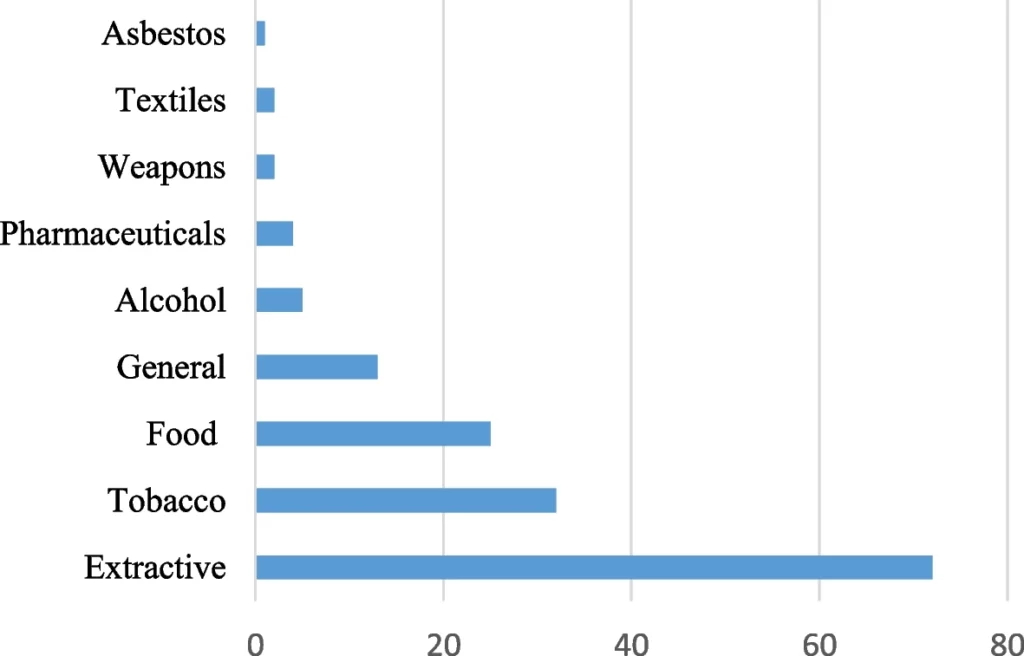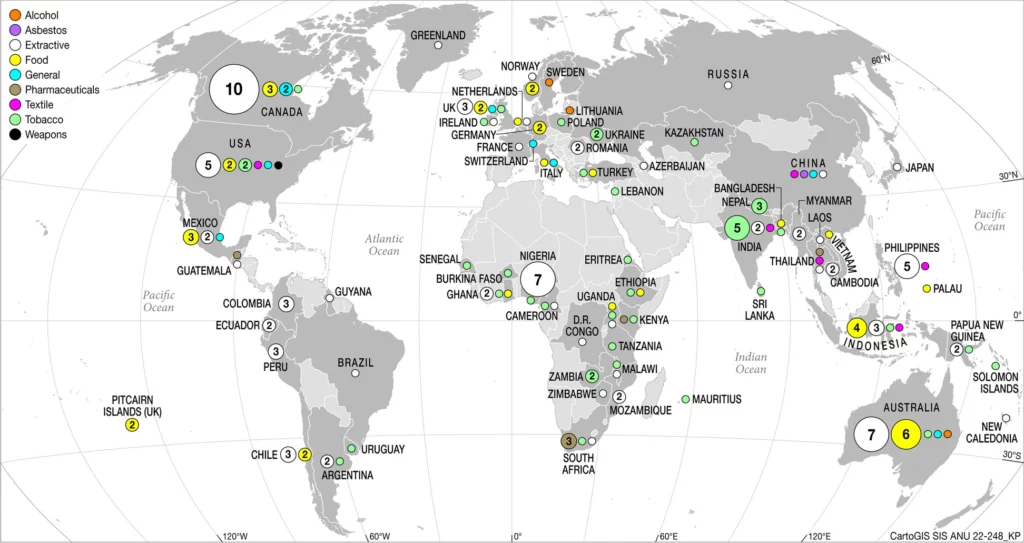A framework of NGO inside and outside strategies in the commercial determinants of health: findings from a narrative review
Review article
Abstract
Background
Public health scholarship has uncovered a wide range of strategies used by industry actors to promote their products and influence government regulation. Less is known about the strategies used by non-government organisations to attempt to influence commercial practices.
This narrative review applies a political science typology to identify a suite of ‘inside’ and ‘outside’ strategies used by NGOs to attempt to influence the commercial determinants of health.
Methods
The researchers conducted a systematic search in Web of Science, ProQuest and Scopus. Articles were eligible for inclusion if they comprised an empirical study, explicitly sought to examine ‘NGOs’, were in English, and identified at least one NGO strategy aimed at commercial and/or government policy and practice.
Results
One hundred forty-four studies met the inclusion criteria.
Eight industry sectors were identified:
- extractive,
- tobacco,
- food,
- alcohol,
- pharmaceuticals,
- weapons,
- textiles and asbestos, and
- a small number of general studies.
The researchers identified 18 types of NGO strategies, categorised according to the target (i.e. commercial actor or government actor) and type of interaction with the target (i.e. inside or outside).
Of these, five NGO ‘inside’ strategies targeted commercial actors directly:
- participation in partnerships and multistakeholder initiatives;
- private meetings and roundtables;
- engaging with company AGMs and shareholders;
- collaborations other than partnerships; and
- litigation.
Four NGO ‘inside’ strategies directly targeting government actors included:
- lobbying;
- drafting legislation, policies and standards;
- providing technical support and training; and
- litigation.
‘Outside’ strategies targeting commercial actors through the mobilisation of public opinion included:
- monitoring and reporting;
- protests at industry sites;
- boycotts;
- directly engaging the public; and
- creative use of alternative spaces.
NGO ‘outside’ strategies targeting government included:
- protests and public campaigns;
- monitoring and reporting;
- forum shifting; and
- proposing and initiating alternative solutions.
We identified three types of NGO impact: substantive, procedural, and normative.
Conclusion
The analysis presents a matrix of NGO strategies used to target commercial and government actors across a range of industry sectors. This framework can be used to guide examination of which NGO strategies are effective and appropriate, and which conditions enable NGO influence.
Background and context
Public health scholarship focused on the commercial determinants of health has uncovered a wide range of strategies used by commercial actors to promote sales of their products and influence government regulation.
Documented strategies include lobbying and political donations, partnering with governments, engaging in multistakeholder platforms, funding research biased in favour of industry, co-opting health professionals and policymakers to promote industry objectives, intimidating critics, undermining legitimate science and reframing debate, and promoting corporate social responsibility initiatives.
The recent Lancet series on the Commercial Determinants of Health (CDoH) defines the commercial determinants as the ‘systems, practices and pathways through which commercial actors drive health and equity’.
Calls for a ‘public health playbook’ point to the need for public health actors to develop a suite of strategies to counter industry power and influence. These actors include experts, think tanks and non-government organisations (NGOs) who can play an important role in the policy process.
NGOs are one particularly important but understudied group of actors who comprise much of civil society and play important roles in holding government and industry actors to account. Within the literature on CDoH, three recent studies emphasise the role of NGOs in agenda setting and acting as ‘watchdogs’ monitoring and reporting on government and commercial practices.
Other studies have highlighted the lobbying role of NGOs targeting government and intergovernmental actors.
The range of strategies that NGOs use, however, is not well documented, particularly strategies directly targeting commercial practices.
NGO tactics tend to be reported in case studies or issues area (e.g. tobacco), and not across domains. There is significant scope for learning lessons from what NGO strategies have been used across CDoH domains.
Key results and insights pertaining to alcohol
Out of 144 studies examined less than ten studies examined alcohol.
Alcohol country level studies focused on Australia (n = 1), Lithuania (n = 1) and Sweden (n = 1).
For instance, in Lithuania, NGOs published a website targeting MPs who voted for cancelling a proposed alcohol advertising ban.
Another example is the study from Sweden assessing and comparing the success of NGO inside and outside strategies targeting a commercial actor. In this case grocers in Sweden, for reducing alcohol sales to minors). The study found that the outside tactic – public shaming of the grocer, was four times more effective than the inside tactic of dialogue in reducing alcohol sales to minors.
The study was unable to assess the impact of particular NGO strategies, as most of the literature did not report this.
But the researchers were able to identify that NGO impact was examined in the literature (in 43 of the studies or 30% of studies) in three ways (see Table 4):
- Substantive impact
- such as significantly influenced commercial practices or government/intergovernmental policy and regulation),
- or partial impact, such as NGOs temporarily influenced policy, e.g. halting mining licenses, or industry responded through voluntary actions,
- Procedural impact,
- such as influencing processes and procedures, e.g. securing representation on committees, greater transparency, or preventing industry representation, and
- Normative impact
- such as where NGOs were identified as having successfully diffused their particular framing in policy, media or corporate discourse.
| Substantive impact | Procedural impact | Normative impact |
| NGO collaboration with state officials at the subnational level in India was key to several Indian states notifying implementation of FCTC Article 5.3, particularly on limiting government-tobacco industry interactions | In Lebanon, NGOs used the FCTC to successfully campaign for industry actors to no longer be included in formal deliberations by parliamentary committees | In another study, while unsuccessful in stopping extractive projects, transnational NGO networks were found to have elevated framing of human rights and concerns about Indigenous people’s rights in the context of extractive industry practices at the global level |
| NGOs successfully pressured a newspaper company in the US to ban advertisements of particular weapons and pressured banks not to finance new extractive industry projects in Australia | In Kerala, India, local officials shut down a Coca Cola bottling plant after an NGO campaigned that it drained and polluted local water | A study of NGO campaigning on tax justice in Australia found that the NGO campaign successfully influenced the public narrative, framing corporate tax avoidance as a “revenue” problem”, which was taken up by the Government and media |
| NGO secured amendments to parliamentary bills to include compensation for communities affected by mining |
Reflections in the strategies employed
The researchers identified 18 types of NGO strategies, categorised according to the target (i.e. commercial actor or government actor) and type of interaction with the target (i.e. inside or outside).
Of these, five NGO ‘inside’ strategies targeted commercial actors directly:
- participation in partnerships and multistakeholder initiatives;
- private meetings and roundtables;
- engaging with company AGMs and shareholders;
- collaborations other than partnerships; and
- litigation.
Four NGO ‘inside’ strategies directly targeting government actors included:
- lobbying;
- drafting legislation, policies and standards;
- providing technical support and training; and
- litigation.
‘Outside’ strategies targeting commercial actors through the mobilisation of public opinion included:
- monitoring and reporting;
- protests at industry sites;
- boycotts;
- directly engaging the public; and
- creative use of alternative spaces.
NGO ‘outside’ strategies targeting government included:
- protests and public campaigns;
- monitoring and reporting;
- forum shifting; and
- proposing and initiating alternative solutions.
These ‘inside’ strategies appeared to sit on a spectrum from collaborative to conflictual, with a common theme being direct engagement with the commercial actor in an attempt to influence change in practice.
Of the NGO ‘inside’ strategies targeting government, lobbying was the most prevalent, followed by; drafting legislation, policies and standards; providing technical support and training; and litigation.
Of particular interest for the NGO ‘outside’ strategies targeting government was the use of forum shifting – where NGOs strategically shifted debate from one policy forum to another in an attempt to obtain favourable influence. Most studies explored NGOs forum shifting vertically – from the national to regional and global level. This supports the ‘boomerang effect’, which describes how NGOs experiencing state blockages can manoeuvre to global forums to put pressure on states via alternative routes.


